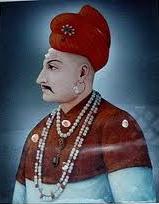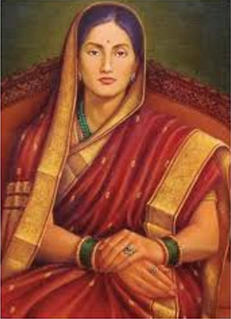
Shivaji Bhonsale I, also referred to as Chhatrapati Shivaji, was an Indian ruler and a member of the Bhonsle Maratha clan. Shivaji carved out an enclave from the declining Adilshahi sultanate of Bijapur that formed the genesis of the Maratha Empire. In 1674, he was formally crowned the Chhatrapati (emperor) of his realm at Raigad.

Sambhaji Bhosale was the second Chhatrapati of the Maratha Empire, who ruled from 1681 to 1689. He was the eldest son of Shivaji, founder of the Marathas. Sambhaji's rule was largely shaped by the ongoing wars between the Maratha kingdom and Mughal Empire as well as other neighbouring powers such as the Siddis, Mysore and the Portuguese in Goa. In 1689, Sambhaji was captured, tortured and executed by the Mughals. He was succeeded as Chhatrapati by his brother, Rajaram I.

The Maratha Empire or the Maratha Confederacy was a power that dominated a large portion of the Indian subcontinent in the 18th century. The empire formally existed from 1674 with the coronation of Shivaji as the Chhatrapati and ended in 1818 with the defeat of Peshwa Bajirao II at the hands of the British East India Company. The Marathas are credited to a large extent for ending Mughal Rule over most of the Indian subcontinent.

The Peshwa was the appointed Prime Minister of the Maratha Empire of the Indian subcontinent. Originally, the Peshwas served as subordinates to the Chhatrapati ; later, under the Bhat family, they became the de facto leaders of the Maratha Confederacy with the Chhatrapati becoming a nominal ruler. During the last years of the Maratha Empire, the Peshwas themselves were reduced to titular leaders, and remained under the authority of the Maratha nobles and the British East India Company.

Shrimant Peshwa Balajirao Bhat, also known as Nana Saheb, was the 8th Peshwa of the Maratha Empire in India. He was appointed as Peshwa in 1740 upon the death of his illustrious father, the Peshwa Bajirao I.

Jijabai Shahaji Bhosale, referred to as Rajmata Jijabai or Jijau, was the mother of Shivaji, founder of the Maratha Empire. She was a daughter of Lakhujirao Jadhav of Sindkhed Raja.
Patil is an Indian last name and a title or surname. The female variant of the title is Patlin or Patlinbai, and is also used to describe the wife of a Patil.

Rajaram Bhosle I was the second son of Maratha emperor Shivaji, and younger half-brother of Sambhaji. He took over the Maratha Empire as its third Chhatrapati after his brother's death at the hands of the Mughal emperor Aurangzeb in 1689. His eleven-year reign was marked with a constant struggle against the Mughals.

The Battle of Palkhed was fought on February 28, 1728 at the village of Palkhed, near the city of Nashik, Maharashtra, India between the Maratha Empire Peshwa, Baji Rao I and the Nizam-ul-Mulk, Asaf Jah I of Hyderabad wherein, the Marathas defeated the Nizam.
Battle of Surat, also known as the Sack of Surat, was a land battle that took place on January 5, 1664, near the city of Surat, Gujarat, India between Maratha ruler Chatrapati Shivaji Maharaj and Inayat Khan, a Mughal captain. The Marathas defeated the Mughal force, and sacked the city of Surat for six days.

Saibai Bhosale was the first wife and chief consort of Shivaji, the founder of the Maratha Empire. She was the mother of her husband's successor and the second Chhatrapati, Sambhaji.

Rajgad is a hill fort situated in the Pune district of Maharashtra, India. Formerly known as Murumdev, the fort was the capital of the Maratha Empire under the rule of Chatrapati Shivaji Maharaj for almost 26 years, after which the capital was moved to the Raigad Fort. Treasures discovered from an adjacent fort called Torna were used to completely build and fortify the Rajgad Fort.

Aundh State was a Maratha princely state in the British Raj, in the Deccan States Agency division of the Bombay Presidency.

Pratap Singh Bhosale was the last Chhatrapati of the Maratha Empire, Satara from 1808 to 1819. However, political power was under the control of Peshwas. He was also the Raja of Satara until 1839, when he was replaced with Shahaji of Satara by the British.
Shahu Bhonsle II was the titular Chhatrapati of the Maratha Empire. A member of the Bhonsle clan, he was succeeded by his son Pratap Singh, Raja of Satara Shahu was nominal ruler in Maratha Empire. During his reign, the Marathas won the First Anglo-Maratha War, but lost the Second Anglo-Maratha War. Mahadaji Shinde and the Peshwa were his closest counterparts. He died on 3rd May, 1808.

Shriniwasrao Parshuram, popularly known as Shripatrao Pratinidhi or Shripatrao Pant Pratinidhi, was a General of the Maratha Empire. He served as Pratinidhi during Chhatrapati Shahu I reign. After the death of his father Parshuram Pant Pratinidhi in 1718, Shripat Rao won the favour of Shahu by his brilliant efforts as a soldier fighting many battles in the defence of the Maratha Empire. In 1718, he was appointed as the Pant Pratinidhi of Maratha Empire.
Jagjivan Rao Pant Pratinidhi served as Pratinidhi during Chhatrapati Shahu I reign. He is the younger brother of Shripatrao Pant Pratinidhi.He succeeded as Pratinidhi after the death of his brother in 1691 at the age of fifty-five.
Annaji Datto Sachiv was the Sachiv in the Ashta Pradhan mandal of the Maratha Empire during the rule of Chhatrapati Shivaji.

Purandare is prominent Indian family of Nobles, Sardars, Patil, Jagirdars during Maratha Empire. They belong to Deshastha Rigvedi Brahmin (DRB) community. Dhondo Malhar Purandare, a member of purandare family held the patilki watan of Vadule, a village in Shevgaon subdivision. Purandare Wada was the seat of the Purandares of the Maratha Empire until 1818, when the Peshwas lost control to the British East India Company after the Third Anglo-Maratha War. The famous Purandare Wada still standing defiantly in Saswad, about 20 miles from Poona.
Yesaji Dadoji Kank also spelled Yesaajee Kunk, was a Koli Sarnobat of seven divisions of Mavala Koli infantry of the Maratha Army of Maratha Empire during the rule of Maratha emperor Shivaji. at the order of Shivaji, Yesaji Kank fought and defeated the drunken elephant of the Mughal emporer Qutub Shah during a meeting of Shivaji and Qutub Shah. In 1645, Yesaji Kank, along with Tanaji Malusare conquered the Torna fort from the Mughals. Yesaji Kank was Zamidar of Bhutonde in the Western Ghats.












